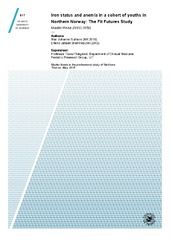Iron status and anemia in a cohort of youths in Northern Norway. The Fit Futures Study
Permanent lenke
https://hdl.handle.net/10037/11074Dato
2015-05-29Type
Master thesisMastergradsoppgave
Sammendrag
Background: Adolescents are at risk of developing iron deficiency (ID) and iron deficiency anemia (IDA) due to rapid growth and sexual maturation.
Objectives: Our objectives were to; (1) examine gender-specific distribution of hemoglobin and ferritin, and whether certain lifestyle factors influence on these; (2) describe the prevalence of iron deficiency, iron deficiency anemia and anemia, and; (3) investigate the applicability of the WHO-criteria for anemia in adolescents in our population.
Methods: Data is gathered from the Fit Futures survey. The survey was conducted in 2010-2011, inviting 1117 students in first year of upper secondary school, and repeated in 2012-2013 inviting all who participated in the former survey. Participants between ages 15-17 in Fit Futures 1 (FF1), with valid Hemoglobin (Hb) values, ferritin<500 and CRP<10 were included; 813 participants in FF1, 561 participants in Fit Futures 2 (FF2). 505 participants met inclusion criteria in both surveys. Participants were considered anemic if Hb<13 for males and Hb<12 for females (WHO guidelines), and iron deficient if ferritin<12. The prevalence of iron deficiency and anemia was compared across surveys.
Results: The prevalence of ID and IDA decreased from 9.5% and 4.9% in FF1 to 6.8% and 3.6% in FF2, respectively. Using the 2.5 percentile for Hb as cut-off, the prevalence of anemia was reduced by two thirds in females (from 20.3% to 6.2% in FF1 and 16.8% to 5.6% in FF2). The male prevalence was practically unchanged. Lifestyle factors (junk food, snacks, sweets, vitamin/mineral supplements, physical activity, menstrual cycle length and BMI-classification) have non-consistent effects on Hb and ferritin.
Conclusion: ID is common in female adolescents in Northern Norway. The 2.5 percentile cut-off for anemia corresponds well with the WHO-criteria in males, but not in females. Future research should apply the 2.5 percentile for Hb as cut-off value for anemia in adolescent females.
Forlag
UiT Norges arktiske universitetUiT The Arctic University of Norway
Metadata
Vis full innførselSamlinger
- Mastergradsoppgaver Helsefak [1337]
Copyright 2015 The Author(s)
Følgende lisensfil er knyttet til denne innførselen:


 English
English norsk
norsk
